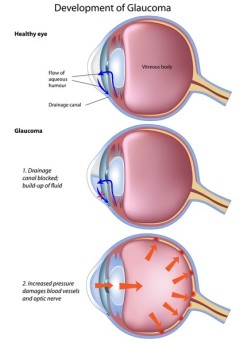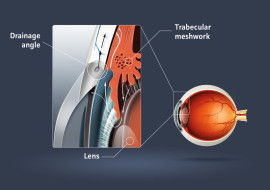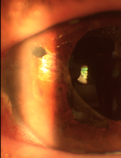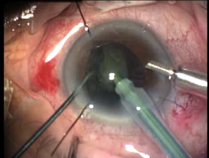
What is angle closure glaucoma?
The aqueous (water) inside the eyes need to be drained away continuously through the 'drainage angle' formed between the iris root and the cornea. Angle closure glaucoma is a condition when the drainage angle is blocked by forward movement of the peripheral iris. This is like the door is being too narrow, when in dark condition (in the evening or in dark room), the pupil dilates and this cause forward movement of the iris and this can cause total angle closure in eyes with already very narrow drainage angle.
What are the differences between open angle and close angle glaucomas?
Open angle glaucoma has open drainage angle but there is blockage at the trabecular meshwork and the channels behind the trabecular meshwork, whereas angle closure glaucoma is a condition when the angle is closed before the trabecular meshwork. This is like the open angle has a open door but the channels behind the door is blocked, however in angle closure glaucoma, the door is closed before the normal channels.
Who are at risk of getting angle closure glaucoma?
There are a few risk factors that have been identified with increased risk of angle closure glaucoma.
- Age (>60 years old)
- Female
- Long-sightedness (hypermetropia)
- Cataract formation
- Family history
- Race (more common in Chinese)
Patients can develop intermittent eye pain commonly happen in the evening when the light level is low. Patients frequently complain of brow-ache or headache on one side or both sides. This can be associated with blurred vision or seeing halos around lights. Patients may feel very unwell, nausea and even sickness. This is called intermittent angle closure attacks. The symptoms may resolve in a few hours but recur again sometime later. When the symptoms does not resolve and continue to get worse, this may become a full angle closure attack when the eye pressures in the eyes are extremely high that need emergency eye treatments. Patients experiencing this problem should attend the nearest eye casualty straight away to prevent permanent damage to the eye sight by the extremely high pressure.
How to treat angle closure glaucoma?
Medications
Urgent treatments with multiple eye drops will be necessary on the patients' arrival to the eye casualty department. This is to constrict the pupil in order to break the angle closure attack. Other eye pressure-lowering medications will also be used including injection of medicine (acetazolamide or Mannitol) to help to bring down the eye pressure quickly.
Laser treatment
Laser iridotomy is a laser treatment that create a small hole at the periphery of iris. This is like when water can not flow to the drain due to the door is closed, a little hole is created to allow water to flow through the door and let the door to open wider. However, laser iridotomy do not always cure the condition, especially when the obstacle behind the door (cataract or a bulky lens) is too large that is pushing the door to shut, a small hole therefore is not enough to allow the door to open up for the water to flow through.
Cataract or clear lens extraction
When laser iridotomy is not enough to open the drainage angle, the lens behind the iris could be too bulky due to cataract formation that pushes against the iris and making the angle very narrow. A lens extraction or a cataract removal surgery with artificial lens implant can be a very effective treatment to open the drainage angle and stop further angle closure attacks.
Nonetheless, when the drainage angle has been closed for too long, the angle may not open even after lens extraction surgery because the angle has been closed for too long and the angle stuck together permanently. Therefore, additional angle opening surgery may be required (namely goniosynechialysis) to open the drainage angle during the lens extraction procedure to allow water to flow through the drainage angle again.
In some rare cases, lens extraction with angle opening surgery is still not enough to control the eye pressure. Further glaucoma drainage surgery (e.g. trabeculectomy or tube-shunt implant procedures) may be required to control the eye pressure in long term.







